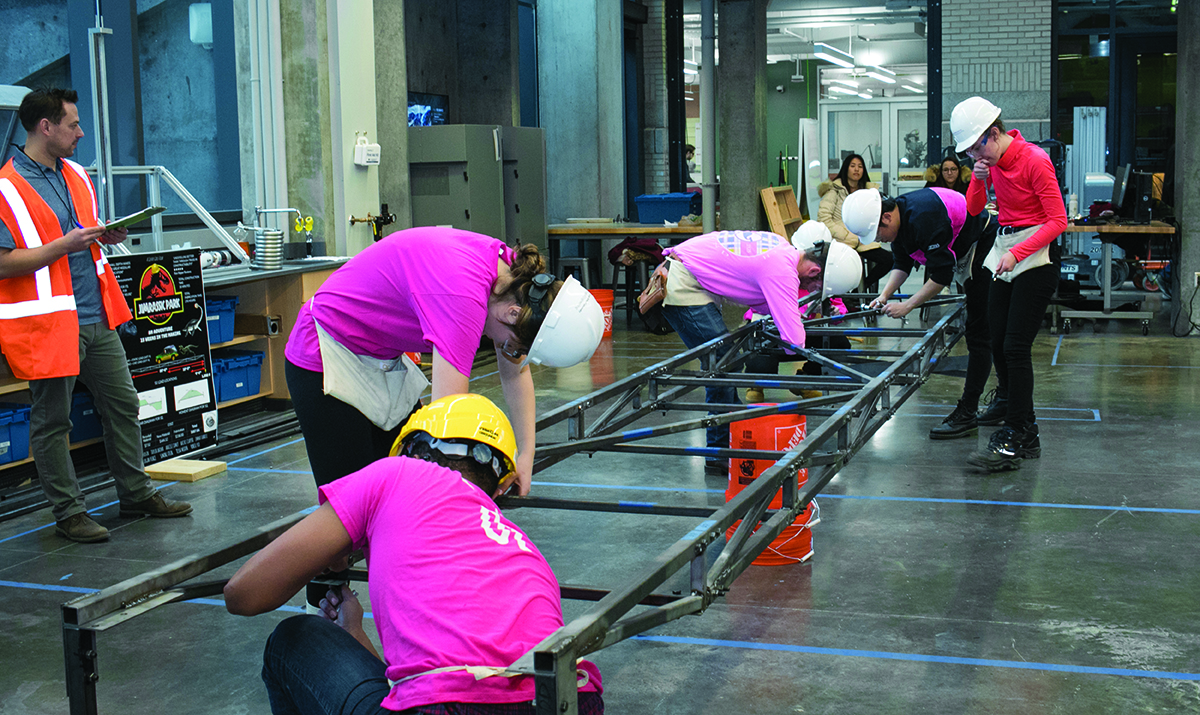
ANSYS HALL: A Creative Epicenter
Walk inside Carnegie Mellon’s ANSYS Hall and you’ll feel an energy in the air. Through glass walls and windowed learning areas, natural light streams into this impressive 36,000-square-foot building. Around computers and tables, you’ll find students debating drawings and digital designs. As the whirring of machinery and clanking of materials draws you further in, you’ll discover students using 3D printers and laser cutters, sawing wood, and welding steel. You’ll see others assembling finished products and complex prototypes of all sizes for course projects, independent research, club activities, entrepreneurship, and more.
In each instance, students are learning what it takes to transform concepts into products and move ideas from paper to the physical world.
Reimagining Course Projects
Fully opened in October 2019 as part of the College of Engineering’s larger maker ecosystem known as TechSpark, ANSYS Hall is a great boon for CEE courses. “What I can do with students just got bigger,” says Jim Thompson, who teaches the 12-401 Civil & Environmental Engineering Design capstone course.
Last fall, Thompson’s students used the facility to complete a timed assembly and testing of the steel bridges they had designed in teams for their final senior project, with each bridge built to be 20 feet long and to hold 2,500 pounds.
“At one time, our workspaces limited the type of projects we could do. In ANSYS, students have room to cut and drill everything, do the welding, and put the whole bridge together in one place,” says Thompson.
Of course, before students work with any specialized equipment, proper safety and technical training are required. After completing their TechSpark training, students can scan their ID near the equipment needed and a green light will signal that they can proceed. A yellow light indicates that training is still ongoing, and a red light alerts the student that training is required before they can continue.
Knowledgeable TechSpark staff—a mix of professionals and trained students—are on hand to offer assistance and ensure safety procedures are followed, with the facilities open through 11:00 pm on most weeknights. “The tools, the expertise, and mostly the supervision let us do things we couldn’t have done before in our classes,” says Thompson.
In addition to senior design, several other CEE courses benefit from the new maker space. In the Fall 2019 first-year design course, students were taught about Arduino sensing by TechSpark staff, while the sophomore design course used the facility in several ways, including to build small-scale retaining walls capable of holding more than 100 pounds of sand. For that project, students used the building’s computer cluster to learn how to design in SolidWorks and AutoCAD. Then, to complete the assignment, they printed 3D components and used the wood shop and laser cutters to prepare materials like wood and cardboard for their builds.
Sophomore design course instructor Sarah Christian hopes that using these tools now will make students more comfortable working with 3D printers and trying other new technologies on the job. Beyond becoming familiar with industry tools, however, students are learning much bigger lessons in the maker space.
Christian explains, “Once you have the ability to build something and know how things go together, you design differently. You consider how things will be made, and you make decisions that simplify construction and save money on labor. Having experience making gives students a better understanding of how to do that.”
Of course, as students work, mistakes happen, challenges arise, and projects often take longer than expected. “Things don’t go as planned,” says CEE sophomore Andrew Thompson. “You think you have it all figured out and then you get to build day. You meant to mark the wood at this inch, but then it’s a quarter-inch off and you’re suddenly making rapid-fire changes to your design. We had to learn to adapt and think on the fly.”
These moments offer another learning opportunity—highlighting the planning and care required for every step from design to construction, as well as the importance of a schedule and budget that anticipates project risks. Through such experiences across their time in CEE, students not only learn how to avoid the temptation to overengineer, but also gain an appreciation of the methods, time, effort, costs, and safety considerations involved in construction and manufacturing.
Making Room for Creativity
Outside of courses, CEE students can visit the ANSYS facilities for any number of other reasons, bringing their own materials to work on or purchasing supplies from TechSpark. Sometimes, they’re lucky enough to be able to reuse scraps left over from other completed projects. “The greatest thing is that students can learn on their own in the maker space courses and then do their own projects, even independently,” says Christian.
CEE junior Benjamin Lawson is among the students employed in the maker space to enforce safety practices, perform equipment maintenance, and teach and help other students. An avid user of the space himself, he has taken nearly every class offered by TechSpark. He recently 3D-printed his own fidget toys, and after making an end table in the wood shop, a coffee table is now in the works. “Between classes and other responsibilities, it can be hard to find spare time for extra projects but I really enjoy it,” says Lawson. “It helps me relax.”
CEE junior Brian Lee is another TechSpark worker who regularly stays in the maker space during his off-hours. He’s also experimenting with building a table and has made custom-engraved coasters for friends and family. “I like being able to make my ideas come true,” he says. “There’s so much opportunity to be creative and so much to learn about how each tool works and how to adjust your drawings to make everything come together smoothly.”
Beyond personal projects, students gather in ANSYS Hall to do work for organizations and activities they’ve joined, from making items and signs for fraternity and sorority events to preparing for Carnegie Mellon’s annual Spring Carnival by building aerodynamic Buggy vehicles and elaborate Booth showpiece structures and decorations.
Entering its third consecutive year, the Rethink the Rink project is another example of the types of collaborations that occur inside the maker space. Co-sponsored by the College of Engineering, the Pittsburgh Penguins, and Covestro, a supplier of high-tech polymer materials, this event challenges students to develop prototypes of products that could make hockey safer without compromising game performance.
With each year focused on a different aspect of player safety, cross-disciplinary student teams participate in a Make-a-thon over spring break, receiving guidance from coaches along with materials and technical expertise from Covestro. In 2018, CEE senior Sally Chen helped her team to re-envision the hockey rink dasher boards and glass. That year, students from 11 different departments participated. In 2019, the focus shifted to players’ equipment, and junior Ryan Rusali was part of the team whose helmet design received the Best Prototype Award.
“It was a great opportunity to collaborate on a project that supports design thinking and engineering thought processes,” Rusali says. “It was everything I could have hoped for and captured all of the reasons why I came to CEE in the first place.”
After the Make-a-thon, prototypes are submitted to the National Hockey League and USA Hockey, with the possibility of future testing at the UPMC Lemieux Sports Complex’s FedExRink in Cranberry, Pennsylvania.
Innovating Together
Rethink the Rink is far from the only interdisciplinary collaboration inside the maker space. The open floor plan, computer cluster, and shared working areas naturally invite students across departments to draw inspiration from each other’s work and strike up conversations that lead to new ideas and new undertakings.
“When we were assembling our bridges and doing poster sessions, we had several interactions with other people in the building,” CEE Professor Thompson recalls. “Because this is a resource for the whole college, everyone mingles more and each department gets exposure to the others. I think that’s a huge benefit.”
CEE students too notice the benefits of spending time outside their comfort zone and the familiar walls of Porter Hall. After finishing up in the maker space, they stick around to chat with friends and often run into people they normally wouldn’t. “It’s a real collaborative spot, where you have people coming together who otherwise wouldn’t be working together,” explains Lawson.
Sometimes, simply walking through the workshops can be educational, as students observe unfamiliar tools, materials, and methods. “We recently purchased a new material for one of our sophomores after he saw someone else using it in ANSYS. He had been unsure of his next move, but his research project is now taking off,” says CEE Facilities & Lab Engineer Brian Belowich. “By seeing other disciplines and other approaches, our students are getting a better education.”
While ANSYS Hall is still new to many, more and more CEE students are getting comfortable with all this facility has to offer. “It’s an incredible privilege to be able to use this technology and these machines. From scissors and markers to 3D printers, the maker space has everything you could need,” says CEE sophomore Greta Markey. “I’m definitely going to use it more now that I’ve used it for class.”
As students keep returning and the ideas keep flowing, the maker space is blossoming into its full potential as a shared collaborative hub for innovation, creativity, and learning—a place where vision and design become reality.
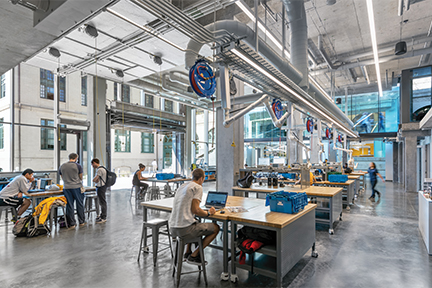
Students can use the high bay to collaborate, build, and test their ideas
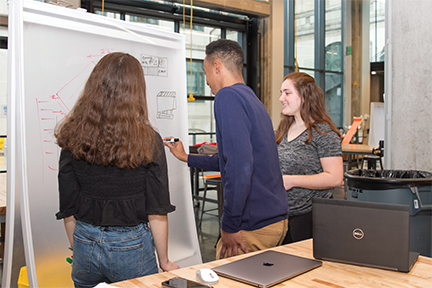
Andrew Thompson collaborates with Lynn Rushkin (Left) and Lauren Heller (right) in the Ansys High Bay
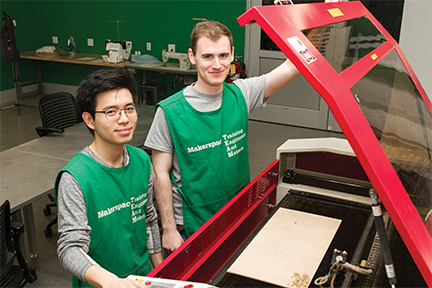
Benjamin Lawson (right) and Brian Lee (left) use laser cutter to create trusses
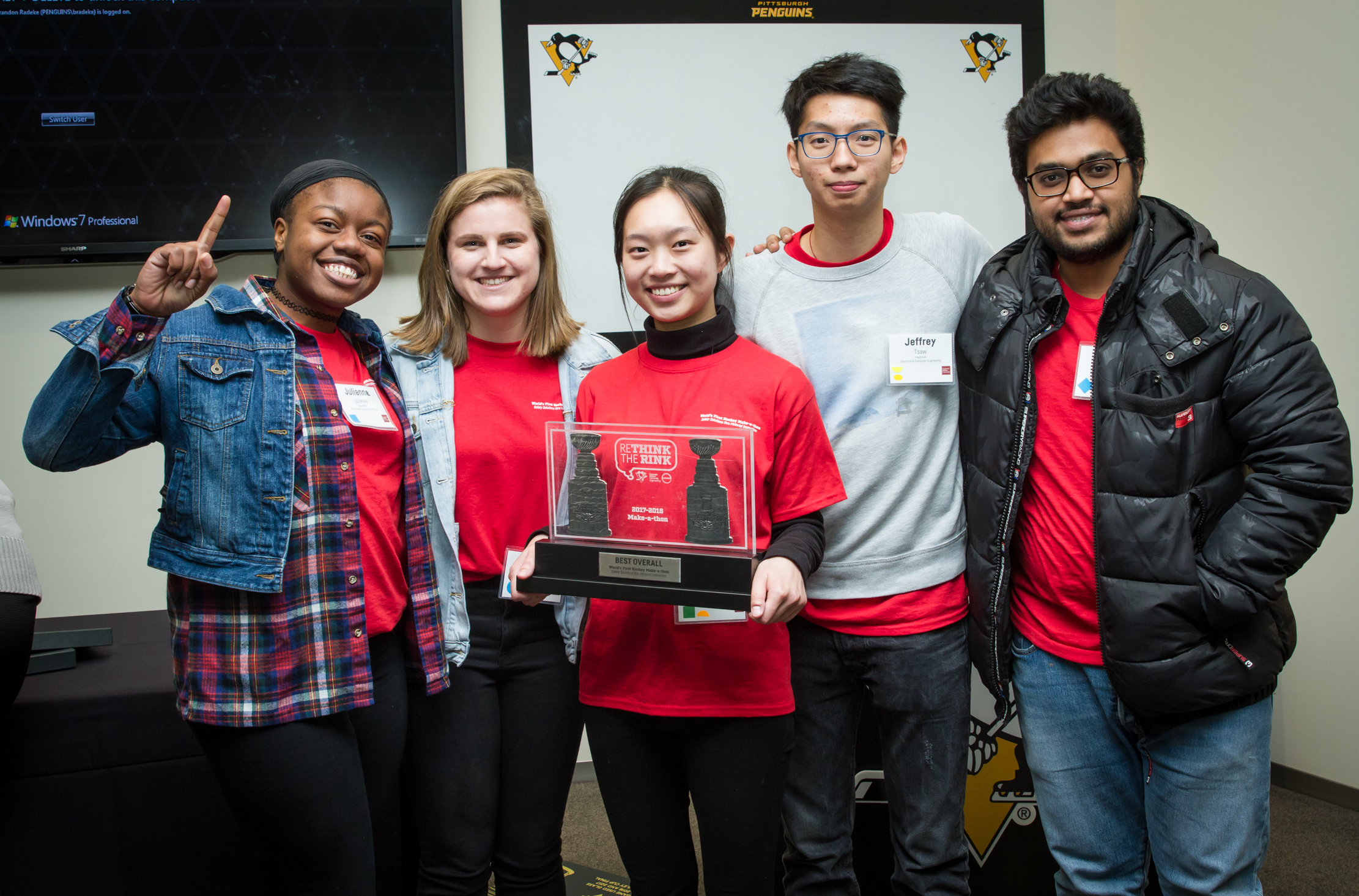
Sally Chen (center) holds her team’s first place award at the 2018 Rethink the Rink competition
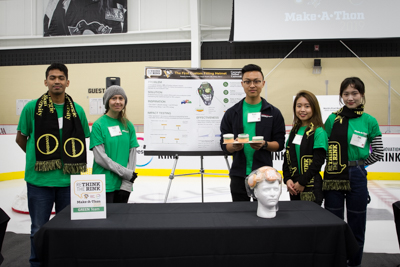
Ryan Rusali holds part of his team’s prototype for a safer hockey helmet at the 2019 Rethink the Rink competition
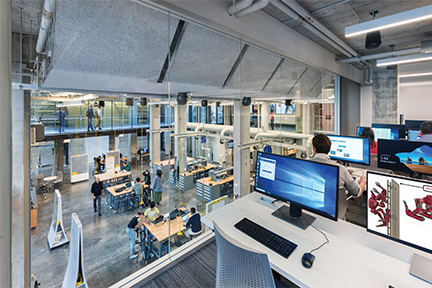
Computer lab overlooks Ansys High Bay